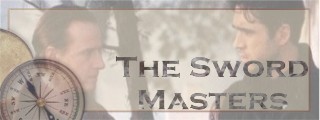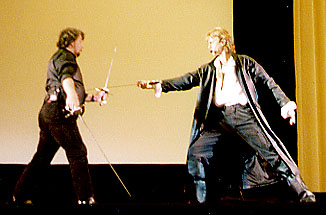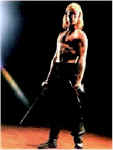|
|
|
|
|
| So do you want to be a Swords Master when you grow up? Here is some of what awaits you in the Choreographer's chair! |
Talking to Robert Chapin By Jan Lopreste
JL: How did you get started in the business? Was it something you always wanted to do or was it "chance?" When did you begin to study swordsmanship? RC: Chance definitely had a hand in it. I got started in swordplay through music actually. I was on a music scholarship at Miami Dade Community College back in 1982 (playing the trumpet). When it became too much for me (8 hours practice a day) I left the music program. One of my instructors, however, said I could keep my scholarship if I took his "Early Music Consortium," where he was desperately trying to find someone who could play a "zinc" - a renaissance trumpet. I was terrible at it, but I've heard that it's not supposed to sound much better than a cat in heat. One of our first performances happened to be at a renaissance fair. I remember my costume made me look like a walking green carpet. The fair, however, was a whole new experience, but nothing was as impressive as the Living Chess game. Here were guys and girls my age doing fantastic choreographed stunts which had the audience cheering like they were at a WWF match. I was hooked. Within three months, my brother and I were directing shows with this group, which still exists today - The Royal Chessmen of Miami, Florida. After almost twenty years, I still quote their logo "Fight Hard, Die Well," and always keep in mind their two rules of stage combat "1 - Don't hurt anyone, and 2 - Don't get hurt." JL: What is the most difficult aspect of learning a duel (encounter, fight sequence?) RC: Performing someone else's choreography can always be a challenge, since no two people move alike. There is also getting used to your fight partner if you haven't worked together before. Unfortunately, there are no real standards for fight choreography and everyone has their own particular style and technique. There can also be egos involved, which is probably one of the most difficult aspects to deal with. Then there are the props, wardrobe, sets, lights, and other
considerations - all of which will conspire to kill you. JL: What is the most enjoyable part of the same process? RC: Performing a fight up to speed is incredibly intense and
exhilarating - makes for a great aerobic workout too. RC: I've never had to do a "Starlight Turn" in the middle of
a swordfight, but I'm sure it helps. Just take a look at Gene Kelley in
the Three Musketeers. Fight choreography and dance choreography are no
different really, you're simply looking for dramatic movement that tells a
story. RC: I started out with heavy weapons and was drawn into the fast
and flashy world of rapier and smallsword. Now (mostly because of
"The Hunted"), I'm back to heavy weapons (broadsword, katana),
but with a fast and flashy style. RC: I think every weapon has its possibilities (creatively). What
I don't like is a performer or choreographer utilizing a weapon that is
unsafe (too sharp or heavy) or inappropriate for the choreography. RC: There are plenty of places out there to learn this stuff if you're interested. Check out the SAFD (www.safd.org) and local renaissance fairs for stage combat groups that offer instruction. It's a lot of fun and it's not impossible to learn. Just remember to play safe!
|
Learn more about what Robert Chapin is doing now in his interview
Don't forget to visit Robert's official web site and to check out his new project "The Hunted" |
|




